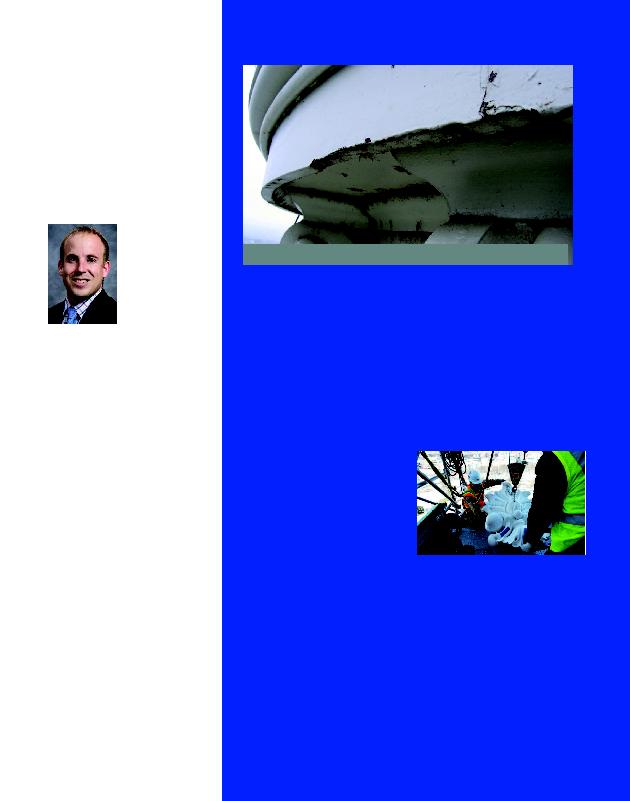
B O N A V E N T U R E
13
W
I
N
T
E
R
2
0
1
6
-
1
7
on the dome too many times to count.
During the summer of 2015, Abriatis
climbed the scaffolding that wound
above the head of the bronze Statue of
Freedom that crowns the dome.
Stamped into one of the bronze feathers
of her headdress is "A. Lincoln Presi-
dent."
It's been an honor for Abriatis, who
earned a B.S. in engineering physics at
Bona's, to be part of a project to restore
what he calls "the most important build-
ing in America."
"The dome is a
symbol of democracy
and freedom that is
known throughout
the world. To be part
of a team that has
worked so hard to
preserve this struc-
ture for future gener-
ations is something
that I will be very
proud of for the rest of my life," he said.
The AOC traces its roots back to 1791
and has been responsible for maintain-
ing and preserving several of the build-
ings on Capitol Hill since George
Washington laid the cornerstone of the
Capitol in 1793.
"What I appreciate most about the
dome is the incredible craftsmanship
that went into this structure over 150
years ago. Buildings just aren't built like
this anymore. So much work went into
these incredible decorative parts know-
ing that level of detail would never be
seen from the ground," Abriatis said.
He's amazed at the intricate and or-
nate structure that was built before
modern tools, equipment and machin-
ery. A steam engine placed on the roof
of the Capitol powered a wooden der-
rick, which was used to erect the struc-
tural steel. Everything else -- from the
columns to the intricate rosettes -- was
done by hand or with hand tools.
The complex restoration work required
very specialized and very skilled crafts-
men. Abriatis was fortunate to be able
to visit the foundry where the new cast
iron was being produced and the facility
where the new cupola glass was being
shaped.
"It was fascinating to meet these
highly skilled craftsmen who worked be-
hind the scenes to fabricate and pro-
duce these replacement parts," he said.
Growing up in the town of Ellicottville,
Joe Abriatis explains how replacement
pieces for the intricate ornamentation
were crafted using some old, and some
not-so-old techniques.
A Blast from the Past
The Capitol Dome is made entirely of cast
iron, a cost effective and widespread build-
ing material during the Industrial Revolution
and late 19th century.
Many of the smaller intricate ornaments
and details were handcarved or sculpted in
clay. Many of the larger utilitarian parts,
such as gutters, would have been made out
of wood. To make the cast iron components
for the dome, workers would create a pat-
tern. After a pattern is created, a mold is
made by pressing the pattern into a mixture
of sand and a bonding agent. This process
creates a void in the sand (or a negative of
the part). Once the sand mold hardens,
molten cast iron is poured into the mold.
When the iron cools, the mold is broken and
peeled away to reveal the new part.
The patterns used to make replacement
parts for the dome today are still hand-
crafted by skilled artisans. The foundry uses
modern magnetic induction furnaces and
has the ability to 3D scan and print some of
the smaller decorative parts into patterns,
however the majority of the process is rela-
tively unchanged from 150 years ago.
What's New
During the last restoration of the Capitol
Dome (1959-1960), many of the broken and
cracked cast iron plates were welded. We
have since learned that welding causes the
cast iron to temper, become extremely hard
and brittle, and then crack.
Many of the welds from 1959-1960 have
cracked, allowing water to leak into the
building. For this restoration, we used a me-
chanical metal stitching process to repair the
8,000 inches of cracks that were discovered
in the dome. This is a modern process that
has been successfully used for repairing
large engines on ships and machinery where
welding is not possible.
A series of double-hooked pins are drilled,
tapped, and inserted into the length of the
crack. The pins overlap to fill and stabilize
the crack and make the repair watertight.
Next, a series of 18 holes are drilled in the
cast iron to create a cavity where a "lock" is
pounded into the iron for additional
strength. The final repair is ground smooth
with the adjacent cast iron and then
painted. This metal stitching process al-
lowed for the field repair of thousands of
inches of cracks. The process takes about
one labor hour to stitch 1.25 inches of
metal.
Behind the scenes
>>
Exposure to the elements caused damage to the cast iron exterior of the dome.
